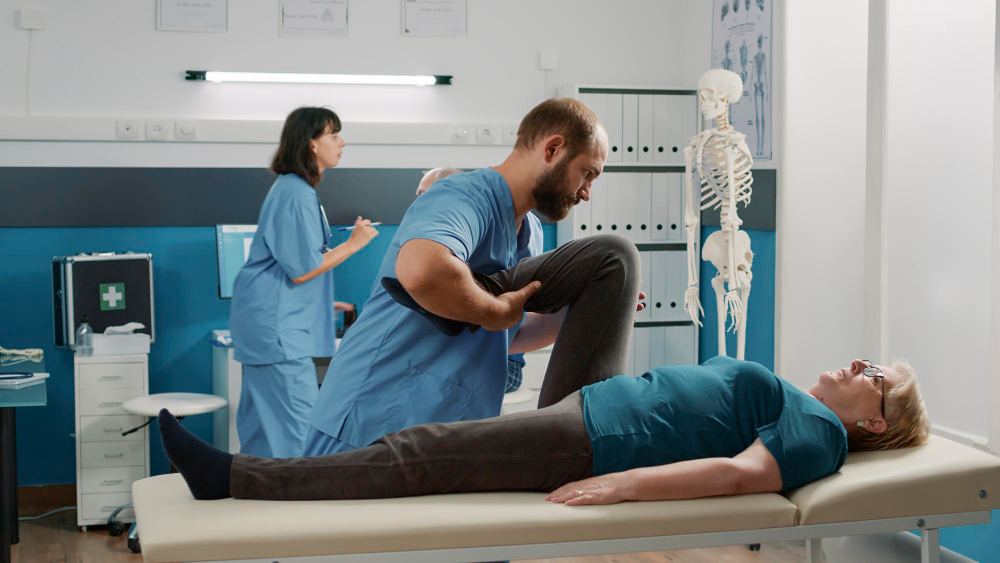**Introduction**
“Recovery Top 5 Mistakes After Knee Replacement surgery is pivotal, yet often riddled with avoidable missteps. From medication routines to rehabilitation, the path to a successful recovery is laden with crucial checkpoints. Discover the quintessential guide to sidestep pitfalls and optimize your post-surgery journey. Uncover the top strategies, common errors to avoid, and expert insights for a seamless recovery ahead.”
**Understanding Preparations for Success**
Successful recovery from knee replacement surgery begins long before the operating room. Preparing both mentally and physically sets the stage for a smoother rehabilitation journey. Here’s a detailed breakdown of the essential preparatory steps:
- **Having a Plan in Place**
Before surgery, creating a well-thought-out plan with your healthcare team is crucial. Discussing expectations, limitations, and rehabilitation goals will help set realistic post-surgery milestones. Understanding what to expect regarding recovery time, rules, and rehabilitation prepares you mentally for the journey ahead.
- **Pre-Surgery Rehabilitation (Prehab)**
Engaging in prehabilitation exercises your healthcare provider recommends significantly contributes to a successful recovery. Prehab helps strengthen the muscles around the knee joint, making post-surgery rehabilitation more manageable. It can also enhance flexibility and improve overall outcomes after surgery.
Taking these proactive steps not only primes your body but also mentally equips you to face the challenges ahead. Preparation is the cornerstone of a successful recovery from knee replacement surgery, setting the tone for what’s to come.
**Avoiding Common Pitfalls**
Recovery after Top 5 Mistakes After Knee Replacement surgery can be derailed by common pitfalls that patients often encounter. Understanding and sidestepping these pitfalls is crucial for a smooth rehabilitation process. Here’s an in-depth look at the mistakes to avoid:
- **Not Being Prepared For Limitations After Surgery**
Refrain from underestimating the post-surgery limitations, leading to frustration and setbacks. Awareness of restrictions like weight-bearing limitations, mobility constraints, and the need for assistance during daily activities is crucial. This awareness helps in making necessary adjustments and arrangements in advance.
- **Not Taking Pain Medication Regularly**
Proper pain management is essential for a comfortable recovery. Failing to adhere to prescribed pain medication schedules can result in unnecessary discomfort, hindering rehabilitation progress. It’s important to follow the medication plan outlined by your healthcare provider.
- **Avoiding Movement or Rehabilitation**
Overprotecting the knee and avoiding movement can impede recovery. Physical therapy and prescribed exercises are pivotal in regaining strength, flexibility, and mobility. Skipping or avoiding these rehabilitation sessions can slow down progress.
- **Doing Too Much Activity Too Soon**
Pushing the limits too soon after surgery can lead to complications or setbacks. Attempting strenuous activities or disregarding post-surgery activity guidelines can strain the healing process, potentially leading to injury or slower recovery.
- **Not Taking Proper Medication**
Apart from pain medication, neglecting other prescribed medications or supplements can impact recovery. Medicines for preventing infection, blood clotting, and other post-surgery complications are equally important and should not be overlooked.
Navigating through these pitfalls demands mindfulness and adherence to the prescribed guidelines. Recognizing and avoiding these common mistakes will pave the way for a more effective and efficient recovery post-knee replacement surgery.
**Optimizing Recovery Strategies**

Recovery strategies post-knee replacement surgery are crucial for a successful rehabilitation process. Maximizing these strategies ensures a smoother and more effective recovery. Here’s an in-depth look at key strategies:
- **Sedentary Lifestyle __ Not Following Prescribed Exercise**
Remaining sedentary post-surgery can hinder progress. It’s vital to adhere to the prescribed exercise regimen provided by your healthcare team. These exercises are tailored to enhance strength, flexibility, and mobility in the knee joint, accelerating recovery.
- **Skipping Physical Therapy And Pain Management Techniques**
Physical therapy sessions and pain management techniques are integral parts of recovery. Skipping or disregarding these sessions can impede progress. Physical therapy aids in regaining strength and mobility, while pain management techniques alleviate discomfort, allowing for better engagement in rehabilitation exercises.
- **Improper Nutrition and Inadequate Hydration After Surgery**
Nutrition and hydration significantly impact recovery. Proper nutrition supports tissue healing and boosts the immune system, while adequate hydration aids in flushing out toxins and facilitates overall recovery. Neglecting these aspects can slow down the healing process.
Optimizing recovery strategies involves a holistic approach encompassing exercise adherence, therapy sessions, and mindful attention to nutritional needs. Embracing these strategies enhances the body’s ability to heal and recuperate effectively after knee replacement surgery.
**Patient’s Guide to Effective Rehabilitation**

Understanding the nuances of rehabilitation after knee replacement surgery empowers patients to participate actively in their recovery. Here’s a comprehensive guide to navigating through this critical phase:
- **Feel Good, Move Well, Be Better**
The mantra of successful recovery revolves around feeling good physically and mentally. Focusing on both aspects aids in a smoother rehabilitation journey. A positive mindset while actively engaging in prescribed exercises and therapies accelerates progress.
- **Top 5 Mistakes After Knee Replacement Surgery**
Reflecting on the top mistakes individuals make post-surgery reinforces the importance of avoiding these pitfalls. Emphasizing preparedness, medication adherence, movement, and gradual activity escalation serves as a guidepost for patients.
- **5 Common Post-Surgery Mistakes**
Delving deeper into common post-surgery errors offers insights into the ramifications of neglecting prescribed protocols. Understanding the implications of inadequate post-surgery care reinforces the significance of adhering to recommendations.
- **Proper Timing and Duration for Icing**
Icing is a simple yet effective technique for managing post-surgery inflammation and pain. Knowing the appropriate timing and duration of icing sessions optimizes its benefits in reducing discomfort and swelling.
- **Giving up Assistive Devices Too Quickly**
Assistive devices aid in mobility and provide support during the initial recovery phase. Prematurely, discontinuing the use of devices can strain the knee joint and hinder rehabilitation progress.
Navigating through effective rehabilitation involves a proactive approach, mindfulness, and a commitment to following prescribed guidelines. Understanding the significance of each aspect and avoiding common pitfalls sets the stage for a successful and efficient recovery journey post-knee replacement surgery.
**Maximizing Post-Surgery Results**

Achieving optimal results after knee replacement surgery involves balancing pushing boundaries and allowing adequate healing. Here’s a detailed breakdown of strategies to maximize post-surgery outcomes:
- **Rushing Back To Work and Driving**
Returning to work or driving before receiving clearance from your healthcare provider can jeopardize recovery. Both activities demand physical exertion and can strain the healing knee joint, potentially leading to setbacks. It’s crucial to follow the recommended timeline for resuming these activities.
- **Pain Medication Timing: Taking Too Much or Stopping Too Soon**
Proper pain management is pivotal for a comfortable recovery. Adhering to the prescribed medication schedule and dosage is essential. Abruptly stopping medication or overusing painkillers can lead to complications or dependency issues.
- **How Not to Have a “Worst Day” After Knee Replacement—Call TCO**
Having a support system, such as contacting your healthcare provider or support team during challenging times. Promptly addressing concerns or potential complications can prevent issues from escalating, ensuring a smoother recovery process.
Maximizing post-surgery results demands a balance between patience and progress. Adhering to guidelines, monitoring pain management, and seeking guidance when needed are key components in achieving successful outcomes after knee replacement surgery.
**Expert Advice and Support**

Accessing expert advice and support significantly enhances the post-knee replacement surgery journey. Here’s a detailed exploration of the invaluable resources available:
- **Are You Looking Out For Help?**
Seeking help and support from healthcare professionals, support groups, friends, and family is pivotal during recovery. Discussing concerns, seeking guidance, and receiving emotional support can alleviate anxieties and facilitate a smoother rehabilitation process.
- **BONUS Video: Top Tips from a Certified Physical Therapist**
Expert advice from certified professionals provides invaluable insights. A video featuring tips and guidance from a certified physical therapist offers visual demonstrations and personalized advice, aiding in understanding and executing rehabilitation exercises effectively.
Accessing expert advice and support bridges the gap between apprehension and confidence during recovery. Utilizing available resources empowers individuals to navigate challenges and uncertainties post-knee replacement surgery with professional guidance and a robust support network.
**Conclusion**
Recovery Top 5 Mistakes After Knee Replacement surgery is a journey laden with crucial checkpoints and potential pitfalls. Each section of this comprehensive guide sheds light on essential aspects of navigating this path effectively. From pre-surgery preparations to accessing expert support, the key takeaways can transform the recovery process:
Understanding the preparatory steps sets the tone for success. Avoiding common pitfalls and optimizing recovery strategies are pivotal in a smooth rehabilitation journey. Embracing effective rehabilitation practices and maximizing post-surgery outcomes demand patience, adherence, and seeking expert advice when needed.
By acknowledging these aspects and committing to a proactive approach, individuals undergoing knee replacement surgery can pave the way for a successful and fulfilling recovery. Empowerment lies in preparation, adherence to guidelines, and seeking support, ensuring a confident and resilient journey toward restored mobility and well-being.
FAQ About Top 5 Mistakes After Knee Replacement
**1. How long does it take to recover fully after knee replacement surgery?**
Recovery timelines vary, but most individuals can resume activities within 3 to 6 months. However, complete recovery may take up to a year, with improvements continuing.
**2. What exercises are recommended post-surgery to aid in recovery?**
Initially, gentle exercises focus on mobility and strengthening, including leg raises, ankle pumps, and short walks. As recovery progresses, more challenging exercises targeting knee flexibility and muscle strengthening are introduced under the guidance of a physical therapist.
**3. When can I drive after knee replacement surgery?**
It’s generally safe to resume driving when you can comfortably and confidently control the vehicle without pain or impairment. Most individuals regain the ability to move within 4 to 6 weeks post-surgery.
**4. Are there any restrictions on activities after knee replacement surgery?**
Initially, there will be restrictions on high-impact activities like running or jumping. After consulting your healthcare provider, low-impact exercises like swimming or cycling are usually permitted. Always avoid activities that cause discomfort or strain on the knee joint.
**5. How can I manage pain after knee replacement surgery?**
Your healthcare provider will prescribe pain medication to manage discomfort. Additionally, icing the knee, elevating it, and adhering to physical therapy exercises can help alleviate pain and swelling.
**6. What are the potential complications or risks associated with knee replacement surgery?**
While rare complications can include infection, blood clots, stiffness, or implant problems, following post-surgery instructions, attending follow-up appointments, and promptly addressing concerns with your healthcare provider can minimize these risks.
**7. When can I return to work after knee replacement surgery?**
Returning to work depends on the nature of your job and your recovery progress. Desk jobs allow a return after a few weeks, while physically demanding jobs require more time, often around 6 to 12 weeks.
**8. Can I engage in sports after knee replacement surgery?**
Low-impact sports like golfing, swimming, or cycling are generally permissible after recovery. High-impact sports involving jumping or quick pivoting might be discouraged to prevent strain on the replaced knee.
**9. Will I need assistive devices like a cane or walker after surgery?**
Initially, assistive devices like a walker or cane may be required to aid mobility. You’ll gradually transition away from these devices as you recover and gain strength.
**10. How long do knee implants last?**
Modern knee implants are durable and can last 15-20 years or longer with proper care. Factors like activity level, body weight, and implant type can influence the implant’s lifespan. Regular follow-ups with your healthcare provider can monitor the implant’s condition over time.






